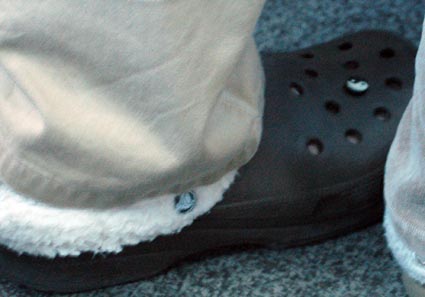Elizabeth’s War Story: Nail Polish for Insights

Elizabeth Chesters is a UX consultant based in London, who volunteers for organizations like EmpowerHack and CodeFirst:Girls. She told this story live at User Research London. Update: the video is here.
I volunteer for EmpowerHack, an organisation dedicated to building technical solutions for refugees. When I joined in 2016, I was working on a project called HaBaby; a mobile app that stores medical records of pregnant refugees and offers symptom cards to help them communicate with doctors. Throughout my time volunteering, I noticed a lot of barriers. One of the biggest was that a lot of people in the organisation did not understand refugees! Many had never spoken to an actual refugee, which led to some wild assumptions (such as how some women had got pregnant or the age they would typically marry).
In April 2016 my team member and I planned a trip to the refugee camps in France. We did not feel comfortable turning up as researchers, as our digital skills didn’t directly help refugees or fit the environment. They needed houses, not interviews. Our plan was to spend as much time as possible observing, in order to better understand issues refugees faced. Our research would then be reported back to the organisation, validating our ideas about what it means to be a refugee and our technical solutions.
The first visit where we were able to talk with refugees was at the Dunkirk camp. Dunkirk was a much cleaner camp than one of the other camps we had been to, The Jungle in Calais. My team member and I met with a volunteer and a group of refugees who were working on an open-source map project. After introductions, we quickly gained the trust of a refugee, who I’ll call “Zach”. We went to his cabin, met the temporary family he had made in the camp and mentioned that we were in the camps to do research.
We walked around the camp, and came across a group of three mothers who were sitting outside with their babies. By the time we communicated to Zach what we were trying to do, so that he could translate for mothers, it was raining. The women looked at us and stood up, gripping their children. Zach explained that the women would not talk to us without trading for makeup. We were testing an app, so we had nothing physical to give them. In the end they went inside to get out of the rain, and we had to walk away… though not without a few marriage proposals from passing men.
On our last day volunteering we were invited to help at a spa day for female refugees in The Jungle. Here we could get close to the women and ask questions in their safe space. This time we also brought makeup to exchange! We turned the top of a donated double-decker bus (with no seats) into a beauty room. Everyone relaxed, leaving their shoes downstairs. We laid out carpet, lined the windows with bunting, and scattered cushions around the room. My friend and I set up our nail polishing stations and settled in for a long day of painting nails.
Throughout the day we were able to meet refugees and ask questions. The women were from all around the world, with the majority from Eritrea, Syria and Afghanistan. Sadly conversations did not flow as well as expected, partly due to my inability to paint nails. Most seemed unamused at my efforts. So, I spent most of my time redoing the same nails and ensuring we still had enough polish for women who would come later.
Halfway through the day journalists from Grazia, a fashion magazine turned up to interview volunteers and refugees about the spa day. They made no effort to ask for help to translate questions. The more questions the journalists asked, the more you could see the women retreat into themselves.
By the end of the day we had no makeup left. I had a makeover done by a little girl and looked like I had two black eyes. My friend also had a bright red face, due to being sat on and having her eyebrows threaded by an Iranian beautician. I walked down to the bottom deck of the bus, to an empty box of shoes. After scanning the whole bottom deck, it became apparent that I no longer had shoes. The other volunteers helped me find something I could wear temporarily. We found a pair of silver slip-on shoes. They were slightly too small, so I had to stand on the back on them. Someone reassured me that I could go to the warehouse to pick a donated pair that fit me. But when I walked outside, the woman we had arrived with (and her car) were gone, our passports along with her. We were now stranded in The Jungle, late in the day, with the warehouse an hour’s walk away. All I could do was pace up and down, frantically phoning volunteers who I knew were at the warehouse. I prayed the woman got my message to stay at the warehouse after dropping off other volunteers, so we could retrieve our passports.
In the end we were rescued by a volunteer called “Superman John”. He drove us back to the warehouse which housed the donations, so we could get our passports back and I could pick out some shoes that fit. I have never been so happy to see that little red book!






